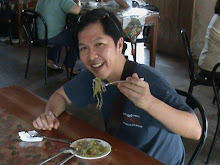Kaibigan,
I went to two play readings of the May-I Lab. One was a children’s play, performed with much enthusiasm and written with charm. It touched on the usual hallmarks of cutesy aphorisms that convince parents that this will be good for their children. Happy End of the World is about cultivating imagination and being proud to be different and all that jazz. Written from a middle class point of view makes the play’s tension a little bit more safe and slack; the lessons learned a bit more shallow, predictable and just a tad unsatisfying. Who said writing for children was easy? But its in the development stage so nothing is written in stone. I'm sure this play will find its way home.
The other play, a re-working of the Hansel and Gretel story, had an interesting premise. Alas, we knew its mettle two minutes into the play. It was all text and no sub-text. This play will begin to show its promise if the writing focused on one story, instead of dissipating the dramatic energy into several sub-plots.
But this Sunday, I also saw The Temperamentals. It tells the personal love story of Harry Hays and Rudy Gernreich and tells it as together with Hay's effort at organizing the Matacchine Society, one of the precursors of the gay political movement. Written in a kind of dula-tula (dramatized monologue) style, it captured my imagination with his technique of dramatizing the historical and compressing arguments to a clarified minimum. I particularly appreciated the first scene of Act II when the actors, donning various hats, represented Harry Hay’s torment and support from the women of his life. This would have taken two chapters in a narrative. In the play, it was reduced to a short scene. I also liked that the play was funny and sad at the same time. It gave me an idea of how best to dramatize an advocacy without sounding didactic or heavy handed. I think the secret is finding the personal, human story that threads the movement. The other thing that struck me with the play’s structure is the way major things were left implied rather than overtly stated. The love story between the two men and their breakup was more profoundly stated because it did not play to melodrama. Restraint seems more effective in these cases.
Finally, I’ve noticed that although the pacing is quick and energetic, the blocking is minimal and contained. The show eliminated all extraneous movements. The actors stand and deliver their lines with the barest of movements, usually in the face. This has the effect of maximizing the gestures (like caressing a face or a hand touching) when finally they make it.
But the reiteration I got from the production was the use of musical interludes—the song in Act 1 and the clarinet solos in Act II—which were used to bridge the narrative as well as a tool for exposition made the play soar, specially because the music was integrated into the action of the play. Dramatically, it is a surprise and a lift. And I know that this will influence me in the way I write my plays in the future.



No comments:
Post a Comment